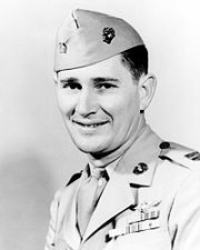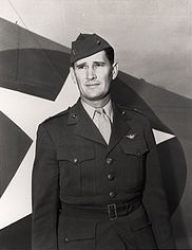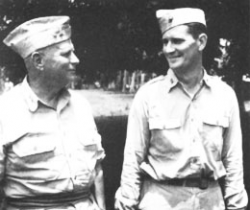
 |
|
|
||
|
Joseph Jacob Foss 'Joe' |
||||
|
Engagements: • World War II (1941 - 1945) |
||||
| Biography: | ||||
|
Joseph Jacob Foss Major Joseph Jacob Foss (17 April 1915 - 1 January 2003) was a U.S. Marine Corps officer and aviator that became the leading Marine fighter ace during World War II. He was a recipient of the Medal of Honor in 1943 for his actions while stationed at Guadalcanal. His post-war achievements include: becoming a Brigadier General in the South Dakota Air National Guard; serving as the 20th Governor of South Dakota; and, serving as the first Commissioner of the American Football League. Joseph Jacob Foss was born on 17 April 1915 on a farm near Sioux Falls, SD. Foss grew up in a farmhouse without electricity. When he was 12, he visited a local airfield in Renner to see Charles Lindbergh on tour with his aircraft, the Spirit of St. Louis. Four years later, he and his father paid $1.50 apiece to take their first aircraft ride. Upon the death of his father in 1933, young Foss took over the running of the family farm but the crops and stock were destroyed by dust storms over the next two years. He worked at a service station to pay for books and college tuition, and flight lessons. While at the University of South Dakota, he joined the Sigma chapter of the Sigma Alpha Epsilon fraternity. By 1940, armed with a pilot certificate and a degree in Business Administration, he enlisted in the Marine Corps Reserves to join the Naval Aviation Cadet program in order to become a Naval Aviator. Military Career World War II Flying Ace After being designated a Naval Aviator and commissioned as a Second Lieutenant, Foss served as an instructor at Pensacola, FL; he later attended the Navy School of Photography. He was then assigned to Marine Photographic Squadron 1 (VMO-1), which was stationed at Naval Air Station North Island in San Diego, CA. Eager for combat, he qualified in Grumman F4F Wildcats while still assigned to VMO-1 and was eventually transferred to Marine Fighting Squadron VMF-115 as the executive officer. In October 1942, VMF-115 was deployed to the South Pacific and became part of the Cactus Air Force in the Battle of Guadalcanal, with Foss serving as the Executive Officer. On combat missions, he led a flight of eight Wildcats that became known as Foss's Flying Circus. He shot down a Japanese Zero in his first combat on 13 October, but his own plane was hit and, with a dead engine and three more Zeros on his tail, he landed at full speed, no flaps and minimal control on the American runway at Guadalcanal, barely missing a grove of palm trees. By the time Foss left Guadalcanal in January 1943, his Flying Circus had shot down 72 Japanese aircraft, including 26 credited to him, five of which were in a single day. As America's "ace of aces," he received the Medal of Honor during a White House ceremony in 1943, and appeared on the cover of Life magazine. Medal of Honor Rank and organization: Captain, U.S. Marine Corps Reserve, Marine Fighting Squadron 121, 1st Marine Aircraft Wing. Place and date: Over Guadalcanal, 9 October to 19 November 1942, 15 and 23 January 1943. Citation: For outstanding heroism and courage above and beyond the call of duty as executive officer of Marine Fighting Squadron 121, 1st Marine Aircraft Wing, at Guadalcanal. Engaging in almost daily combat with the enemy from 9 October to 19 November 1942, Capt. Foss personally shot down 23 Japanese planes and damaged others so severely that their destruction was extremely probable. In addition, during this period, he successfully led a large number of escort missions, skillfully covering reconnaissance, bombing, and photographic planes as well as surface craft. On 15 January 1943, he added 3 more enemy planes to his already brilliant successes for a record of aerial combat achievement unsurpassed in this war. Boldly searching out an approaching enemy force on 25 January, Capt. Foss led his 8 F-4F Marine planes and 4 Army P-38's into action and, undaunted by tremendously superior numbers, intercepted and struck with such force that 4 Japanese fighters were shot down and the bombers were turned back without releasing a single bomb. His remarkable flying skill, inspiring leadership, and indomitable fighting spirit were distinctive factors in the defense of strategic American positions on Guadalcanal. Even though all of Foss's 26 victories were gained as a Marine Corps aviator, the service continues to recognize Gregory Boyington as its leading ace. This is due to Boyington's wartime claims of 6 victories scored while serving with the American Volunteer Group (Flying Tigers) prior to rejoining the Marine Corps, though the documented records prove otherwise (AVG records only show 2). (See Dr. Frank Olynyk, Stars and Bars: A Tribute to the American Fighter Ace, 1995.) Currently, the Marines credit Boyington with 28 victories: six with the AVG in China and 22 with the Marine Corps, the last two being un-witnessed. Boyington's total score recognized by the American Fighter Aces Association is twenty-four: 2 with the AVG and 22 claimed with the Marine Corps. Boyington thus ranks behind Foss (26) and Robert M. Hanson (25). AVG records reflect that Boyington was paid for 3.5 enemy aircraft destroyed (2-air, 1.5-ground). Foss returned to the Pacific in command of VMF-115 during 1944 but contracted malaria and was medically returned to the U.S. A postwar attempt to film a story of Foss's life, starring John Wayne, fell through when Foss refused to allow the producers to add a fictitious love story. Air National Guard After the war, Foss opened a charter flying service and flight instruction school. He later became a car salesman. He also helped organize the South Dakota Air National Guard; commanded the Guard's 175th Fighter-Interceptor Squadron as a Lieutenant Colonel; and eventually reached the rank of Brigadier General. During the Korean War, Foss, then a Colonel, was called to active duty with the U.S. Air Force and served as a Director of Operations and Training for the Central Air Defense Command. Medals and Awards Medal of Honor Political Career Foss served two elected terms in the South Dakota legislature and, beginning in 1955, as his state's Republican Governor. During his tenure as governor, he accompanied Tom Brokaw, then a high school student and Governor of South Dakota Boys State, to New York City for a joint appearance on a television game show. Later, Brokaw would feature Foss prominently in his book about World War II veterans, The Greatest Generation. In 1958, Foss unsuccessfully sought a seat in the U.S. House of Representatives, having been defeated by the Democrat George Stanley McGovern in a year particularly discouraging to Republicans nationwide. Later Career After his 1958 election loss, Foss became commissioner of the new American Football League in 1959. He oversaw the emergence of the league as the genesis of modern professional football, then stepped aside as commissioner in 1966, two months before the NFL agreed to merge with the AFL. Foss' many charities included the Easter Seals campaign, Campus Crusade for Christ, and an Arizona program for disadvantaged youths. Foss hosted ABC television's The American Sportsman from 1964 to 1967. He was succeeded in that position by Grits Gresham, an outdoors journalist from Natchitoches, LA. Foss then hosted a syndicated program, The Outdoorsman: Joe Foss from 1967 to 1974. He also served as President of the National Rifle Association from 1988 to 1990, and appeared on the cover of Time Magazine wearing a Stetson hat and holding a revolver. In 2000, Foss served as a consultant on the popular computer game 'Combat Flight Simulator 2' by Microsoft. In 2001, Foss and his wife, Didi, founded the Joe Foss Institute, a 501(c) (3) nonprofit organization that is still active today in promoting patriotism, public service, integrity and an appreciation for America's freedoms. The Institute recruits military veterans to go into classrooms across the country to interact with students in presentations designed to help students appreciate our freedoms and to learn about the U.S. Constitution. On 11 January 2002, Foss, then in his mid-80s, gained renewed fame when he was stopped at the Phoenix Sky Harbor International Airport because he was carrying his Medal of Honor (which has pointed edges), along with a clearly marked dummy-bullet keychain and a small knife (with MOH insignia) on his way to giving a speech to a class at the U.S. Military Academy at West Point. The subsequent delay and lack of recognition of the award, together with his age, were used as an example of an alleged widespread abuse of passengers by airport security personnel pre-TSA. The story later attained urban-legend status before it was held as true by snopes.com, a popular "last word" on such claims. Foss coauthored or was the subject of three books including the wartime Joe Foss: Flying Marine (with Walter Simmons); Top Guns (with Matthew Brennan); and A Proud American by his wife, Donna Wild Foss. Foss also provided the foreword to Above and Beyond: the Aviation Medals of Honor by Barrett Tillman. Death and Burial Joseph Jacob Foss died on New Year's Day 2003 following a severe stroke three months earlier. He is buried at Arlington National Cemetery in Arlington, VA, in Section 7A, Lot 162. |
||||
| Honoree ID: 1392 | Created by: MHOH | |||
Ribbons
Medals
Badges
Honoree Photos
 |  |  |
 |  |
 |


